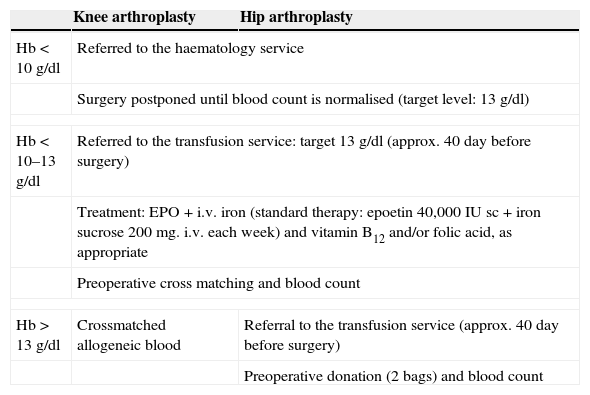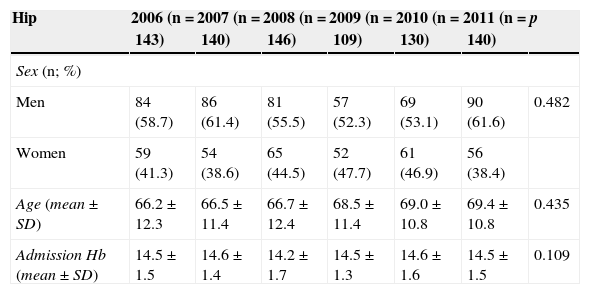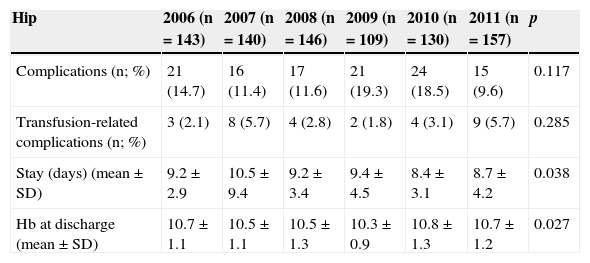To assess the impact of implementing a Patient Blood Management program (PBM) on transfusion rates, hospital stay, and complications for total hip arthroplasty (THA) and total knee arthroplasty (TKA).
Materials and methodsA retrospective, observational study was conducted in Araba University Hospital from 2006 to 2011. All THA and TKA were included. The percentage of patients transfused with allogeneic blood was the primary endpoint. The mean of transfused blood bags, overall transfusion, complications (both overall and specific), patient age and sex, pre-operative and discharge haemoglobin, and hospital stay were recorded.
ResultsA total of 825 THA and 875 TKA were included. Both THA (47.6% in 2006 and 30.6% in 2011; p=.013) and TKA (33.6% in 2006 and 16.2% in 2011; p<.001) showed a significant decrease of allogeneic transfusion. The overall transfusion rate was also reduced in THA (65.7% in 2006 and 39.5% in 2011; p<.001) and TKA (38.3% in 2006 and 17.2% in 2011; p<.001). Hospital stay was reduced in both types of surgeries (p<.038 in THA and p<.0001 in TKA). In 2006 it was 9.2±2.9 days for THA and 11.1±4.7 days for TKA, whereas in 2011 it was 8.7±4.2 and 9.5±3.4 days for THA and TKA, respectively.
ConclusionsOur patient blood management has decreased the percentage of patients that need both allogeneic and autologous transfusion in a statistically significant way. Although the mean hospital stay decreased, the impact of the PBM cannot be established.
Describir el impacto de la introducción de un programa de ahorro de sangre (PAS) en las transfusiones, estancias hospitalarias y complicaciones debidas a la artroplastia total de cadera (ATC) y artroplastia total de rodilla (ATR).
Material y métodosEstudio observacional retrospectivo en el Hospital Universitario Araba, de 2006 a 2011. Se recogieron todas las ATR y ATC. La variable principal fue el porcentaje de pacientes transfundidos con sangre alogénica. Como variables secundarias se recogió la media de bolsas transfundidas, transfusiones totales (alogénica y/o autóloga), las complicaciones (totales y específicas), la edad y el sexo de los pacientes, hemoglobina prequirúrgica y al alta y la estancia hospitalaria.
ResultadosSe incluyeron un total un total de 825 ATC y 875 ATR. Tanto en ATC (47,6% en 2006 y 30,6% en 2011; p=0,013) como ATR (33,6% en 2006 y 16,2% en 2011; p<0,001) se produjo una disminución significativa en las transfusiones alogénicas. Las transfusiones totales también disminuyeron en ATC (65,7% en 2006 y 39,5% en 2011; p<0,001) y ATR (38,3% en 2006 y 17,2% en 2011; p<0,001). La estancia disminuyó en ambas cirugías (p=0,038 en ATC y p<0,0001 en ATR). En 2006 fue de 9,2±2,9 días en ATC y 11,1±4,7 días en ATR, mientras que en 2011 fue de 8,7±4,2 y 9,5±3,4 días para ATC y ATR respectivamente.
ConclusionesLa implementación del PAS, y sus aportaciones consecutivas, ha reducido significativamente el porcentaje de pacientes que requieren transfusiones, tanto alogénicas como autólogas. La estancia media disminuyó aunque no pueda establecerse el impacto del PAS en las mismas.










